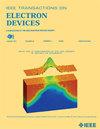重离子诱导SiC mosfet单事件泄漏电流II的微结构损伤
IF 2.9
2区 工程技术
Q2 ENGINEERING, ELECTRICAL & ELECTRONIC
引用次数: 0
摘要
本文研究了181Ta重离子辐照下碳化硅(SiC) mosfet的电学特性和与单事件泄漏电流II (SELC II)退化相关的微观结构损伤。对于1200 V的SiC mosfet,在450和600 V的漏极偏置下观察到SELC II的降解。辐射后,当漏极偏压施加时,在受SELC II降解影响的SiC mosfet中发现了两种不同的泄漏电流路径。漏源漏路与栅极氧化物损伤无关,仅在超过特定电压阈值后才会出现。在辐照和辐照后的SiC mosfet和p-i-n二极管中观察到相似的电学行为,表明p-n结在SiC mosfet的SELC II降解中起关键作用。高分辨率TEM分析也首次揭示了SELC ii诱导的微观结构损伤,包括空腔、位错和取向错位,集中在SiC mosfet中p阱区和n层之间的界面。本文章由计算机程序翻译,如有差异,请以英文原文为准。
Microstructure Damage for Single-Event Leakage Current II in SiC MOSFETs Induced by Heavy Ion
This article investigates the electrical characteristics and microstructure damage associated with single-event leakage current II (SELC II) degradation in silicon carbide (SiC) MOSFETs subjected to 181Ta heavy-ion irradiation. For 1200-V SiC MOSFETs, SELC II degradation was observed at drain biases between 450 and 600 V. Postirradiation, two distinct leakage current paths were identified in SiC MOSFETs affected by SELC II degradation when a drain bias was applied. The drain-source leakage path, which operates independent of gate oxide damage, appeared only after a specific voltage threshold was surpassed. Similar electrical behavior observed in both irradiated and postirradiated SiC MOSFETs and p-i-n diodes indicates that the p-n junction plays a key role in the SELC II degradation of SiC MOSFETs. High-resolution TEM analysis also reveals that, for the first time, SELC II-induced microstructural damage, including cavities, dislocations, and misorientations, concentrated at the interface between the P-well region and the N-epilayer in SiC MOSFETs.
求助全文
通过发布文献求助,成功后即可免费获取论文全文。
去求助
来源期刊

IEEE Transactions on Electron Devices
工程技术-工程:电子与电气
CiteScore
5.80
自引率
16.10%
发文量
937
审稿时长
3.8 months
期刊介绍:
IEEE Transactions on Electron Devices publishes original and significant contributions relating to the theory, modeling, design, performance and reliability of electron and ion integrated circuit devices and interconnects, involving insulators, metals, organic materials, micro-plasmas, semiconductors, quantum-effect structures, vacuum devices, and emerging materials with applications in bioelectronics, biomedical electronics, computation, communications, displays, microelectromechanics, imaging, micro-actuators, nanoelectronics, optoelectronics, photovoltaics, power ICs and micro-sensors. Tutorial and review papers on these subjects are also published and occasional special issues appear to present a collection of papers which treat particular areas in more depth and breadth.
 求助内容:
求助内容: 应助结果提醒方式:
应助结果提醒方式:


